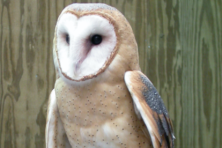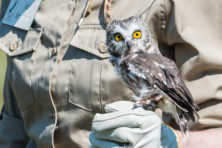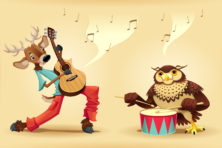Give a Hoot about Owls
- Share
- Tweet
- Pin
- Share
I have the feeling that most people care very little about owls. My guess is that they have had few, if any, real experiences with these exciting and secretive birds, which are so wonderfully designed for darkness.
Winter is the perfect time of the year to get to know the owls of your area better. Walking in the woods and frozen swamps is easy now, and your chances of accidentally flushing an owl from its daytime roost are fairly good. Barred Owls are well known for their daytime hunting.
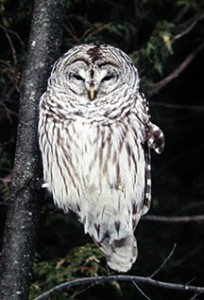
A Barred Owl waited on a tree branch near our garage until a mouse came into view.
It is hard to believe that the Great-horned Owl hens will be incubating eggs a full two months before we will hear the feeble notes of the first Spring Peepers warming for their early April concert. Yes, January is owl courtship time, regardless of how cold it is.
Young cock owls will be singing up a storm in order to attract their first hen owls. The older established pairs of owls will also be singing, a function that in part stimulates ovulation.
You may be wondering how the cocks and hens recognize each other. Outwardly they are alike, except females are as much as a quarter to a third larger than the males. The male owls are extremely aware of and sensitive to the responses of other owls. A hen’s voice, in answer to the cock’s singing, is different in quality and response.
Strangely, even though the hen owls are larger than the cocks, their voices are higher pitched, softer, and their songs are shorter and simpler. The males have the deeper, richer and mellower voices. I seem to remember reading that an average note of the Great-horned Owl is around middle C, 256 vibrations per second. Supposedly the sound does not carry very far, unlike that of the Snowy Owl of the far north. The deep voice of this awesome white owl is said to carry up to seven miles over the frozen, whisper-quiet, snow-covered tundra.
Some of the winter hooting of owls can also be described as territorial assertion, as though they are saying, “I was here first, this is my hunting ground, and keep your distance – or else!”
I shouldn’t do it, but instinctively I want to side with and to sympathize with certain wild creatures. For example I dread the thought of the Great-horned Owl killing the Cottontail which, like clockwork, pussyfoots at dusk from the woods south of our garage to the feeder area where it feasts upon the spilled food scattered there.
The Ruffed Grouse too is fair game for the “tiger of the air.” How we would miss the Grouse’s performances as it soon will be eating buds high in the Sugar Maples and Ironwoods in our front yard in the late afternoon. Interestingly the hearing ability of the Horned Owls is phenomenal but the range does not extend far enough downward to enable it to hear the drumming of the Ruffed Grouse, which is about 40 vibrations per second. The mighty owl must see the grouse drumming and moving in order to pursue it.
No doubt you’ve heard of “eating crow.” Well, the Great-horned Owls do! Crows mob and pester the big owls by day, but the Horned Owls raid the Crow roosts by night and eat the big black birds. Little wonder crows hate owls.
Investigate a cawing screaming flock of crows sometime and surely a Great-horned or Barred Owl will be their target. Come to think of it, I doubt that a crow all by itself would dare to come anywhere near a large owl. Do you suppose some individual crows are chicken?
Depending upon the conditions of the wild mouse population, the depth of snow or other varying conditions, the Barred Owls will practically hunt around the clock. Barred owls are well renowned for their daylight hunting near buildings. It is there that the probability of seeing mice is the highest. The mice, attracted to birdseed upon the ground, or perhaps to food scraps around a dog’s dish, rank high on the Barred Owls’ diet.
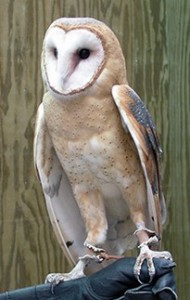
This captive Barn Owl was being rehabilitated so it could be returned to the wild.
Owls in general disguise their true personality. You could call this creature the bird version of a wolf in sheep’s clothing. Like overgrown house cats with wings, they are born killers. No! I don’t want to kill the Great-horned Owl for eating a Cottontail or Ruffed Grouse any more than I’d demand the butcher be killed for slaughtering the cow that provided the hamburgers we ate.
It is man, the busy, large-brained, enterprising hominid that has had considerable influence on virtually every form of life on this planet – much of it bad. Owls do not eat themselves out of business. The number of surviving owls this coming February will depend upon the availability of food.
Man has the capacity to mold and alter the environment to suit his whims and needs. Gradually he is doing away with certain owls including the Barn and the Spotted Owls. Deep down I think that people could learn a lot by studying the ways of these unusually wonderful birds, the owls. Please! Give a hoot!’
•••
How I’ve been enjoying the exquisite, gentle snowfall as I write this on the morning of Jan. 13, 2015. I vividly recall the first year of my life during which I didn’t enjoy a single snowflake, let alone a snowfall. It was while serving in the U.S. Army at Fort Sill, Oklahoma from 1953 – 1955. I had so much fun showing my buddies the black/white photographs my parents sent of the snowfall back home in Kewaunee. One of the most surprising photos included the four inches of snow that fell during the first week of May 1953. I can imagine a few of my southern buddies exclaiming, “And you like living up north?”
One of my favorite items to share with my junior high students in past years on a snowy day was playing for them a favorite big band recording of “Snowfall,” by Claude Thornhill’s excellent orchestra. We have one of Charlotte’s Thornhill albums dating back about 50 years and will enjoy listening to this very piece in a few minutes while we watch the snow fall, gently, like little chicken feathers floating downward.
Were he alive, would the famous Snowflake Bentley ever be busy and enjoying photographing these masterpieces of nature.

